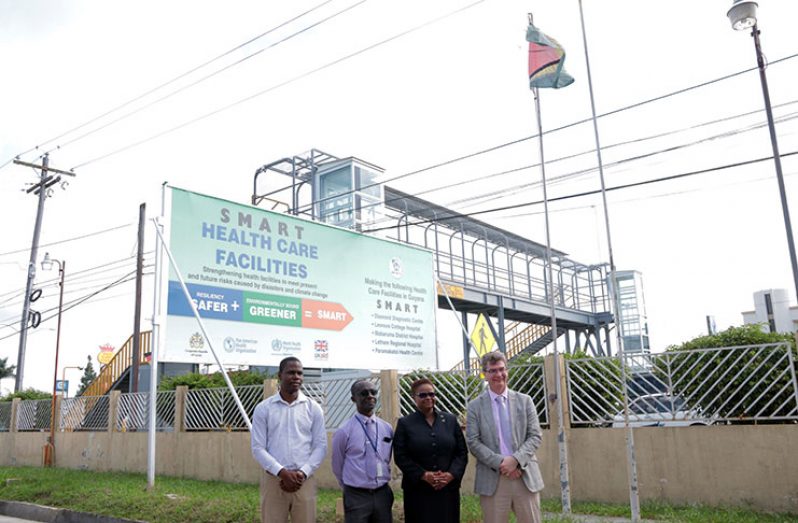…stakeholders mount billboard to raise awareness
THE PUBLIC Health Ministry in collaboration with the United Kingdom (UK) and the Pan American Health Organisation/World Health Organisation (PAHO/WHO), on Monday, unveiled a billboard for the Smart Healthcare Facilities’ Project.
The unveiling of the billboard at the Diamond Diagnostic Centre on the East Bank of Demerara (E.B.D), is intended to raise greater awareness on the US$4.175M project. Under this initiative, five health facilities – Mabaruma District Hospital, Leonora Cottage Hospital, Diamond Diagnostic Centre, Lethem Regional Hospital and the Paramakatoi Health Centre – will be upgraded to withstand natural disasters. Currently the designs for the five facilities are being finalised, and it is expected that construction will commence in April 2019.
During a simple ceremony to mark the occasion, Public Health Minister Volda Lawrence explained that the retrofitting of the health facilities will enable them to respond to emergency situations caused by natural disasters and climate. While building their resilience forms a critical part of the multi-million dollar project, the public health minister said the facilities, when completed, would become more accessible.
“It is one of free flow, one whereby the services can be provided in such a manner that there is no cumbersomeness in terms of the patients accessing the services, and the staff being able to provide those services,” Minister Lawrence told those present.
With the population of Diamond and the neighbouring communities rapidly expanding, the public health minister said the Diamond Diagnostic Centre is ideal for the project. “Persons living in the various communities next to this diagnostic centre will benefit greatly from it,” she posited, while alluding to the fact that the hospital is located on the East Bank Demerara (E.B.D) corridor which leads to the city, the Cheddi Jagan International Airport (CJIA) and the hinterland.
“So we see the Diamond Diagnostic Centre as a pivotal element within the whole health spectrum, and this initiative will certainly provide care at a higher level for those persons who would want to use the services here,” the public health minister said.
With construction earmarked for April, the Public Health Ministry would be taking the necessary steps to boost human capacity, not only at the Diamond Diagnostic Centre but also at the other health facilities identified under the project.
“Even as we work on our human resources in terms of having specialists here, we now have an emergency department, we want to ensure that we can be able to provide those specialists with the necessary tools, space and accommodation so that they would be able to provide the best service that they can,” the public health minister said.
She noted that the project would not have been possible without the support of the British High Commission and PAHO/WHO. The project is being funded by the UK. With such partnership, Minister Lawrence is optimistic that Guyana would be able to achieve its Sustainable Development Goals (SDGs).
With climate change being a pervasive threat, PAHO/WHO Representative, Dr William Adu-Krow said it is imperative that organisations implement purposive, appropriate and cogent interventions to exculpate the adverse effects of climate change. Smart Healthcare Facilities Project is one such initiative, he said.
Dr. Adu-Krow said the health facilities when completely retrofitted would not only be able to “stand the test of time”, but would also become green facilities. They will be operated utilising renewable resources. He said safer, plus greener facilities equal smart facilities.
British High Commissioner to Guyana, Greg Quinn, who was also present, said the UK is pleased to be a part of a process that would positively impact the lives of people in various parts of the country. “The fundamental goal for us is to ensure that no matter what happens, no matter where it happens or how it happens, that people will still have access to fundamental healthcare which is so important,” the diplomat said.
When completed, the facilities will have a sound roof and foundation, back-up power, disaster management plans and disability access and water reserve. Additionally, they will harvest rainwater, have alternative power (renewable energy), waste management, improved indoor air quality and reduce pollution.
The local project forms part of a larger regional initiative. In total, 50 health facilities in Grenada, St Vincent and the Grenadines, Saint Lucia, Dominica, Belize, Guyana and Jamaica, will be retrofitted. The project will come to an end in 2020.



.jpg)









